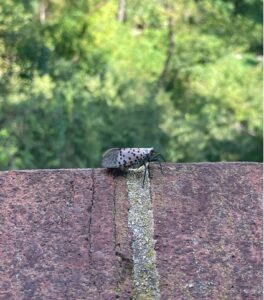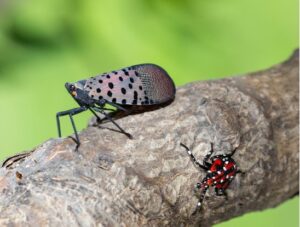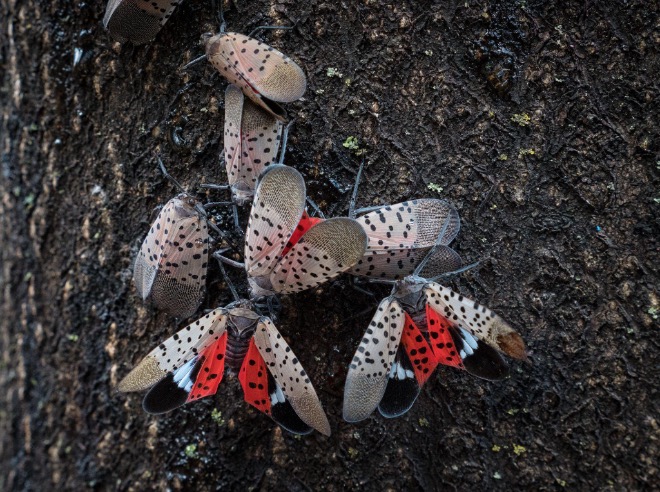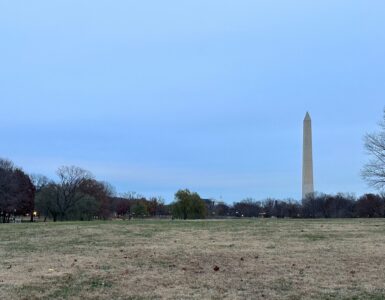By Harper Johnston
The rapid population growth of the invasive spotted lanternfly in Washington, D.C., and beyond poses a threat to local ecosystems. These pests frequently catch unnoticed rides on vehicles, complicating containment efforts and making it easier for the insect to spread.
The spotted lanternfly, an invasive planthopper species, was first detected in the United States about a decade ago and has since spread into 17 states, including Maryland and Virginia. The infestation in Washington, D.C. is becoming less active as the temperature cools, but populations were at their highest this summer and are expected to be worse next year.
Originally from Asia, the insect likely arrived as a stowaway on shipments from overseas. The spotted lanternfly has rapidly expanded across the U.S. since its introduction, mainly because it has no specific predators in the country and is a terrific hitchhiker. The species poses a significant threat to many native plants, some of which fuel large agricultural industries.
First detected in Pennsylvania in 2014, the spotted lanternfly reached Maryland in 2018 and D.C. shortly thereafter. Jessica Boyles, coordinator for the Spotted Lanternfly Program at the Maryland Department of Agriculture, said that the infestation within Maryland has recently picked up speed. “The last few years, so I would say 2021 to about now, we have seen a much more rapid expansion than we had in the previous years.”
The spotted lanternfly’s diet is diverse and contains multiple economically important crops, such as grapevines, fruit trees, and maple trees. The species is labeled as a stressor. It often contributes to, but does not directly cause, the death of its host plant. While not proven to be solely responsible for the decline of other plants, the species has killed grapevines all on its own.

Boyles, who is from Maryland, expressed concern for grapevine populations and those whose incomes depend on them. “That intense feeding does kill those vines … which is a huge problem, of course for the vine, but also for our local farmers.”
Over 1,000 acres of land in Maryland alone are dedicated to growing grapes. So far, no reports have quantified the impact of spotted lanternflies on agricultural economies or labor markets in and around Washington.
Matthew Travis, national policy manager at the USDA’s Animal and Plant Health Inspection Service, wrote that damages due to spotted lanternflies are scattered and inconsistent. This makes it difficult to calculate the species’ economic impact. “Further study is needed to estimate the economic and environmental impact spotted lanternfly has on all the species it feeds on in suburban and forested environments,” said Travis.
A sap-sucking insect, the spotted lanternfly endangers the health of plants it feeds on. Spotted lanternflies are unable to fully digest all the sugar in sap. They excrete all the excess liquid, which is referred to as honeydew. This substance, which can attract other unwanted pests such as wasps and allow sooty mold to grow, builds up wherever spotted lanternflies feed.
Sooty mold leaves a dark stain that can cover anything on or near infested trees. Sooty mold can limit a plant’s ability to photosynthesize, leaving plants weakened and vulnerable to other dangers.
Damien Ossi, wildlife biologist for the Department of Energy and Environment, does not think the spotted lanternfly will heavily impact forests in Washington. However, the insect’s honeydew attracts stinging insects like wasps and yellow jackets. Ossi wrote, “In the district the lanternflies will be more of a nuisance than they will impact any industries or natural systems.”
Spotted lanternflies are bad flyers according to Boyles and cannot cover miles of ground on their own. She added, “They also, quite frankly, don’t have to.” Spotted lanternflies are feeding generalists, meaning that they can survive on various plants. The insect officially has 70 secondary plant hosts recorded in Maryland but only one primary host: the tree of heaven.
The tree of heaven is also an invasive species originating from Asia. Boyles explained that, if in the presence of the tree of heaven, the spotted lanternfly will always gravitate toward it over other hosts.

Travis said he does not find this surprising. When talking about the tree of heaven, he said “It’s known and native to the countries that spotted lanternfly exist in and are coming from … it’s a tree that the insect is familiar with.”
Multiple quarantines have been issued in Maryland, Virginia, and other states in attempts to slow and stop spotted lanternfly infestations. Ossi wrote that while there are no quarantine regulations in Washington, people moving between the district and its bordering states are subject to the quarantines in those areas.
Boyles said that even counties under quarantine are not highly infested throughout. There are varying levels of infestation. The most infested pockets, she said, typically surround highly populated cities. People frequently transport spotted lanternflies unknowingly. The species can catch rides on cars, buses, and even planes.
A research study found that spotted lanternflies might be attracted to certain vibrations. While the study is ongoing, Travis said that he observed behavioral patterns out in the field. “We certainly have seen anything with a motor, with any kind of vibration, an engine, anything like that, we’ve seen spotted lanternfly aggregate to those areas.”
Female spotted lanternflies lay egg masses from September through November before all the adults die due to the first hard frost of fall. All adult spotted lanternflies will be dead within a month. But hordes of egg masses, if undisturbed, will hatch in the spring and revive the infestation.
Travis said there have been a few effective policies implemented to stop spotted lanternflies from spreading, but public engagement remains one of the most beneficial tools for containment efforts. Travis said, “The better educated they are, the better engaged they are, the more information we learn through their eyes and through their reporting.”
Boyles also believes that outreach and education are essential to managing this invasive insect. She said, “The more we educate the general public and businesses that could contribute to such a horrific factor such as hitchhiking, the more we’re able to contain populations.”
Knowing how to identify spotted lanternflies throughout their life cycle is just the first step according to Travis. He said that people need to report each sighting, preferably with photo evidence. People should report spotted lanternfly sightings to their state’s Plant Health Director or Plant Regulatory Official.
Once a sighting is reported, Travis said there is one more step for those who feel up to the task. “If you can, feel free to smash them, feel free to step on them. That may not be the most effective in some people’s eyes, but I think in some areas, it is going to have some impact.”















Fascinating article with lots of good information! I will be on the lookout for the spotted lanternfly!!
We take care of a nature preserve in Princeton, NJ, called Herrontown Woods. We had lots of spotted lanternflies a few years back, but their population has crashed. I just saw a few this year, huddled on the last few sprouts of Ailanthus, the tree they gravitate to. I’d guess that predators have upped their game. If only the same could be said for the many other invasive species that continue to dominate without any clear counter force. The highly visible spotted lanternfly, arriving with such fanfare, has receded as a threat, while the far more stealthy Emerald Ash Borer still wreaks havoc, killing many thousands of trees, and it looks like an introduced microscopic nematode will devastate our beech trees as well. What cannot be seen often proves to be the most dangerous, with rising levels of carbon dioxide and methane in the atmosphere being the most dramatic example. International trade remains a free for all, transporting species helter skelter from one continent to another. Looks like we got lucky with spotted lanternfly, but with so many other introduced species, our senses, and our sense, fail us.